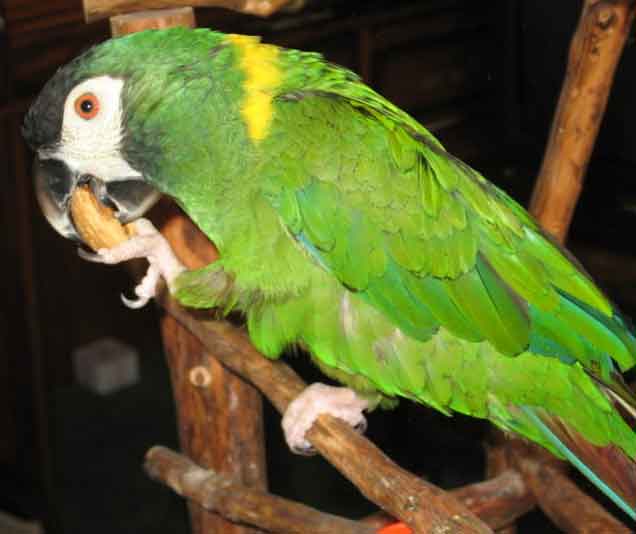Primolius auricollis (*) Cladus: Eukaryota Name Primolius auricollis (Cassin, 1853) Synonyms * Propyrrhura auricollis Reference Proceedings of the Academy of Natural Sciences of Philadelphia 6 p.372 Vernacular Name ----------- The Golden-collared Macaw or Yellow-collared Macaw (Primolius auricollis) is a small species of macaw belonging to the parrot family Psittacidae. It is native to central South America. In recent years it has often been placed in the genus Propyrrhura, but this is incorrect as per ICZN rules. Earlier, it has also been placed in the genus Ara, which at present only is used for some of the larger macaws. The Golden-collared Macaw was described by America n ornithologist John Cassin in 1853. Its specific epithet auricollis meaning gold-collared, from the Latin aurum 'gold', and collum 'neck'.[1] In recent years it has often been placed in the genus Propyrrhura, but this is incorrect as per ICZN rules. Earlier, it has also been placed in the genus Ara, which at present only is used for some of the larger macaws. Description Distribution The main population occurs in the Pantanal of Brazil (south-western Mato Grosso, western Mato Grosso do Sul and southern Rondônia), northern Argentina (eastern Jujuy and northern Salta), far northern Paraguay (Alto Paraguay and Concepción) and most of northern and eastern Bolivia (Beni, Santa Cruz, Chuquisaca and Tarija). A second disjunct population occurs in far north-eastern Mato Grosso, south-eastern Pará and western Tocantins in Brazil. Habitat and status It occurs in forest (but avoids the Amazon Rainforest), woodland, savanna and grassland with scatted trees. It mainly occurs in lowlands, but locally up to an altitude of 1700 m (5600 ft). It is generally fairly common and therefore considered to be of Least Concern by BirdLife International. Behavior Typically seen in pairs or, during non-breeding season, small flocks. Feeds on fruits, flower buds and seeds. Breeding The Golden-collared Macaw nest in a hole in a tree. The eggs are white and there are usually two or three in a clutch. The female incubates the eggs for about 26 days, and the chicks fledge from the nest about 70 days after hatching.[2] References 1. ^ Simpson DP (1979). Cassell's Latin Dictionary (5 ed.). London: Cassell Ltd.. p. 883. ISBN 0-304-52257-0. * BirdLife International (2006). Primolius auricollis. 2006. IUCN Red List of Threatened Species. IUCN 2006. www.iucnredlist.org. Retrieved on 23 June 2007. Database entry includes justification for why this species is Least Concern.
Source: Wikispecies, Wikipedia: All text is available under the terms of the GNU Free Documentation License |
|

